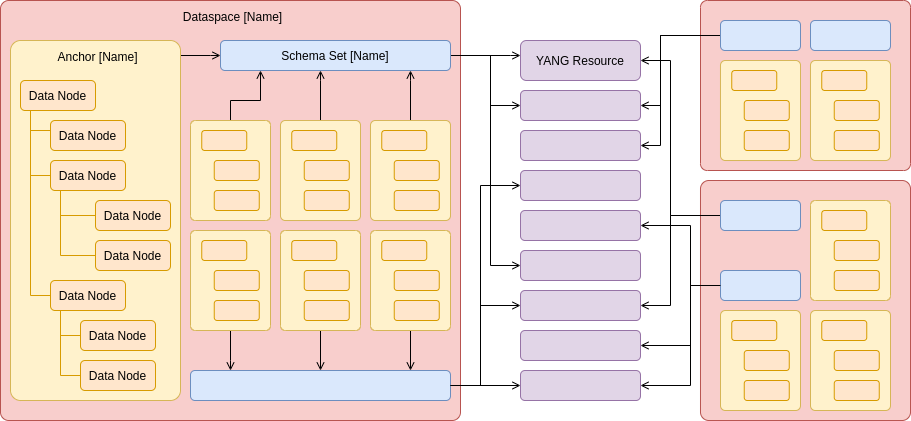CPS Modeling
CPS-Core Modeling
Data Model

Basic Concepts
Administrative entities
Dataspace is a primary logical separation of data.
Any application can define its own dataspace to store the model(s) and data it owns. Dataspace is uniquely identified by it’s name.
Schema Set describes a data model(s).
Schema Set holds reference(s) to single or multiple YANG modules. Schema Set belongs to dataspace and uniquely identified by its name (within its own dataspace). Same YANG resources (source files) can be referenced by multiple schema sets from different dataspaces.
Anchor identifies the unique data set (data record) within a dataspace.
Anchor always references a schema set within same dataspace which describes a data model of associated data. Multiple anchors may reference same schema set. Anchor is uniquely identified by its name (within own dataspace).
Data
Data Node represents a data fragment.
Each data node can have zero or more descendants and together they form a data instance tree. The data node tree belongs to an anchor.
Data node is representing a data fragment described in a YANG model as a container and/or a list. The data described as a leaf and/or a leaf-list are stored within a parent data node.
The data node position within a tree is uniquely identified by the node’s unique xpath which can be used for partial data query.
Querying
CPS Path is used to query data nodes.
NCMP Modeling
Data Model
NCMP stores DMI-Plugin and CM Handle relations using a data model described as per this Yang module.
Note: Although additional-properties are present in the model of the dmi-registry, these are considered private metadata and as such are not queryable.
Basic Concepts
CM-Handle represents an instance a modeled Network Function(node) in ONAP.
These are stored as Anchors within CPS-Core.
CM-Handle States are used to represent the potential states in which a CM-Handle can transition between.
The 5 possible CM-Handle states are: ADVISED, READY, LOCKED, DELETING, DELETED
ADVISED indicates that a CM-Handle has been registered successfully, and is waiting for the module synchronization process to sync the CM-Handle.
READY indicates that the CM-Handle has been synced successfully.
LOCKED indicates that the CM-Handle has not synced successfully. A retry mechanism within CPS will set the state back to ADVISED after a set time.
DELETING indicates that the CM-Handle is currently being deleted.
DELETED indicates that the CM-Handle has been deleted successfully.
Data-sync state is the state of the data synchronization process of the CM-Handle
There are 3 possibles states: NONE_REQUESTED, UNSYNCHRONIZED, SYNCHRONIZED
NONE_REQUESTED indicates that the data sync is not requested by the user
UNSYNCHRONIZED indicates the cm-handle is waiting for the data sync watchdog operation to carry out the sync process
SYNCHRONIZED indicates the watchdog process has finished the data synchronization successfully
Datastores represent different views of the cm data.
Datastores are defined for NCMP to access the CPS running or operational datastores. Currently supported datastores are:
Datastore
Configurations
Data access type
Passthrough-operational
config-true, config-false
read-only
Passthrough-running
config-true
read-write
Querying CM Handles
CM Handle Searches Endpoints are used to query CM Handles.